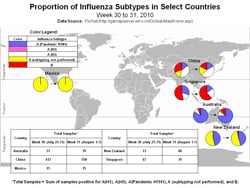Seasonal Flu: International Situation Update
submited by pub4world at Aug, 29, 2010 4:57 AM from CDC
Seasonal Flu: International Situation Update
August 17, 2010, 1:00 PM ET
This report provides an update to the international flu situation using data reported by the World Health Organization (WHO) on August 20.
Global Flu Activity Update
Overall, flu activity due to 2009 H1N1 and seasonal flu viruses varies worldwide, with locally intense 2009 H1N1 activity in India and New Zealand.
Northern Temperate
In the Northern Hemisphere, flu activity has been low or sporadic.
Southern Temperate
In the Southern Hemisphere, levels of flu activity are generally low, with the exception of South Africa and New Zealand. South Africa experienced active circulation of influenza A (H3N2) and B viruses from June through mid-August.
In New Zealand, influenza like illness (ILI) rates increased markedly early in August. 2009 H1N1 activity has been intense in areas that were not as affected during the 2009 pandemic wave. Countrywide, ILI rates and severe cases of 2009 H1N1 have been lower than rates seen during the 2009 pandemic.
In Argentina, there are unconfirmed reports of local flu outbreaks.
India
2009 H1N1 activity is moderately intense in some states, including Maharashtra. Laboratory testing shows an increase in pPositive respiratory (nose, throat and lung) samples from patients infected with 2009 H1N1 virus have increased in Maharashtra since mid-June, and 2009 H1N1 activity does not appear to have peaked. In a number of other states, flu-positive cases have reached a plateau or are decreasing. Seasonal influenza B viruses are also circulating in India.
Selected Highlights
- On August 10th, 2010, the WHO Director-General declared that the 2009 H1N1 influenza pandemic was over. .
- According to WHO, the majority of 2009 H1N1 virus isolates tested worldwide remains sensitive to oseltamivir, an antiviral medicine used to treat flu. Among 2009 H1N1 isolates tested worldwide, 304 have been found to be resistant to oseltamivir as of August 18th. Approximately 1% of U.S. 2009 H1N1 viruses tested by CDC since September 1, 2009, have been resistant to oseltamivir.
- Globally 33.4% of subtyped influenza A viruses were 2009 H1N1, according to WHO data collected from August 1-7, 2010, and reported on August 19th.
- On February 18, 2010, WHO published recommendations for the following viruses to be used for influenza vaccines in the 2010-2011 influenza season of the Northern Hemisphere:
- an A/California/7/2009 (H1N1)-like virus;
- an A/Perth/16/2009 (H3N2)-like virus*;
- a B/Brisbane/60/2008-like virus. vaccine virus.
* A/Wisconsin/15/2009 is an A/Perth/16/2009 (H3N2)-like virus and is a 2010 Southern Hemisphere



